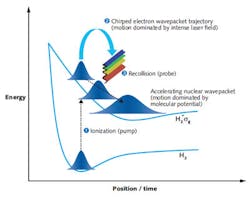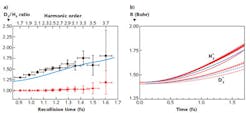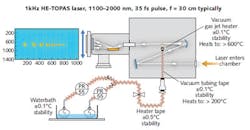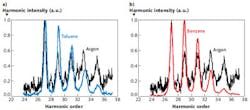Ultrafast Lasers: High-harmonic-generation spectroscopy is extended to new types of molecules
FELICITY MCGRATH, THOMAS SIEGEL, DANE AUSTIN, and JON MARANGOS
Physical and chemical changes that occur in atomic and molecular systems, including structural deformations and electronic motion, typically occur at femtosecond (fs) and attosecond (as) timescales. Measurements of these phenomena have thus far been performed with free-electron lasers (FELs) and pump-probe experiments. One key limitation of these methods is the temporal and spatial resolution they afford.
High-harmonic-generation (HHG) spectroscopy has proven to be a promising tool in revealing the structure as well as the electronic and nuclear dynamics in diatomic molecules, with the potential for subangstrom spatial resolution and subfemtosecond temporal resolution. This field of research was boosted with the advent of commercial optical parametric amplifier (OPA) systems that offer high-intensity femtosecond-duration laser pulses in the mid-IR. Research in this field is now being conducted worldwide, with contributions being made from groups including The National Research Council (NRC; Canada), ETH Zurich (Switzerland), JILA-University of Colorado (Boulder, CO), Weizmann Institute (Israel), CELIA-University of Bordeaux (France), and University of Tokyo (Japan), to name but a few.
This article will review some illustrative experiments pioneered in simple molecules using HHG spectroscopy and will present recent advances made in our laboratory at Imperial College London for extending HHG spectroscopy to new molecular species.
Molecular high-harmonic-generation spectroscopy
High-harmonic generation can be described by the widely used three-step model.1-3 The first step is ionization, in which a high-intensity (~1014 W/cm2) linearly polarized laser field distorts the molecular potential such that a portion of the bound electron wavepacket can tunnel-ionize. The second step is propagation, in which the free electron is accelerated by the laser field. When the field changes direction, the electron gets driven back towards the parent ion. If the electron gets close to the parent ion, there is a probability of recollision; this is the third (recombination) step. If the electron recollides, it can result in the emission of a photon with energy hω = Ekin + Ip, where Ekin is the kinetic energy gained by the electron in the laser field and Ip is the ionization potential of the molecule.
Molecular HHG spectroscopy exploits the chirped nature of the harmonic radiation-different harmonics are generated at different excursion times. We can gain an insight into not only the electronic structure, but also the nuclear dynamics of a molecule.
One powerful technique for probing the structural rearrangements of molecules following ionization has been demonstrated in our group. Probing attosecond dynamics by chirp-encoded recollisions (PACER) offers unprecedented time resolution of the intramolecular nuclear dynamics, allowing tracking with a resolution of 100 as.4,5 Techniques such as PACER arise from the "pump-probe" capability intrinsic to HHG in which the triggering and probing of dynamics can be achieved (see Fig. 1).
The experiment is easy to implement, involving recording HHG spectra from a protonated and deuterated molecule at the same gas density and laser parameters. This comparison excludes the electronic part of the dipole, which is nearly identical in these species, and isolates the nuclear motion. Interferometric measurements are used to verify that the same gas density is delivered to the interaction region for both molecules. This technique was pioneered in hydrogen (H2) and deuterium (D2) molecules.
In the PACER, ionization launches an electron wavepacket into the continuum and simultaneously launches a nuclear wavepacket on the H2+ ground-state potential-energy surface σg. The recollision step of HHG acts as a probe of the nuclear motion that has occurred in the time since ionization. A genetic algorithm is used to retrieve information on the internuclear separation versus time for both molecules, generating the optimum Born-Oppenheimer potential by calculating the wavepacket motion.4
Figure 2a illustrates the experimental data obtained using an 8 fs laser pulse centered at 775 nm and focused to an intensity of 2.4 × 1014 W/cm2. A short laser pulse is used to minimize any degree of alignment of the sample, which can give rise to two-center interference that masks the nuclear dynamics we are looking to isolate. An increase in harmonic signal is clearly observable as harmonic order, which corresponds to the electron return time, increases. The 775 nm drive wavelength gives us a probe window from 0.9–1.6 fs post-ionization, with a temporal resolution of ~100 as. Figure 2b shows the nuclear dynamics retrieved from the experimental data by implementing the genetic algorithm.What we can interpret from this data is that the H2 molecule is at an equilibrium separation of 1.41 Bohrs (0.75 Å) and upon promotion to the H2+ potential surface (a near vertical transition as shown in Figure 1), the wavepacket starts to move towards the H2+ equilibrium separation of 1.75 Bohrs (1 Å).
PACER has proven to be a reliable and powerful tool for imaging nuclear rearrangements in molecules. Our plans to extend HHG spectroscopy to new molecular species will see the PACER technique being implemented in more complex systems.
We can also exploit HHG to gain information on the electronic structure of a molecule. Previous fundamental work in this area includes tomographic imaging of orbitals,6 multi-orbital contributions to HHG,7 and spectroscopy of small aligned hydrocarbon molecules.8 Experiments performed in 2008 in the nitrogen molecule revealed a contribution to the harmonic signal from underlying molecular orbitals.9
More complex molecules
HHG spectroscopy has been applied to a number of diatomic and triatomic molecules and small organic molecules. With the progress being made in the laser technology necessary for performing these experiments, we can now look to extending these spectroscopic methods to larger molecules.
One class of molecules of specific interest is benzene. Benzene and its derivatives provide a variety of geometrical and electronic structures to investigate. It is a low-ionization-potential (9.2 eV) molecule with a high degree of symmetry, which makes it an ideal candidate for HHG spectroscopy. The delocalized π electron environment can be probed by substitutions of halogen or methyl groups on the ring. Its availability as a deuterated species also makes it a candidate for PACER experiments.
These molecules are in a liquid phase at room temperature so we need to adapt our conventional HHG chamber for working with a vapor. Figure 3 illustrates the apparatus currently being implemented to perform these experiments. A number of stainless steel vessels can be attached to the apparatus, each containing an organic liquid, and are then heated in a high-stability water bath to generate the required vapor pressure. A series of commercial heater tapes are wrapped around the stainless steel lines to prevent condensation of the vapor, and a similar heater is installed inside the vacuum chamber. The laser beam enters the vacuum chamber and is focused onto the vapor jet. The generated harmonics are dispersed by a flat-field grating onto a microchannel plate (MCP) detector, the back of which is imaged onto a CCD. Spectra are recorded on a computer. The MCP detector is mounted on a moving flange so lower or higher harmonic orders can be accessed, giving us a larger time window to track dynamics.Another key development pertaining to the laser technology is the use of longer drive wavelengths. For example, calculations of the time-frequency mapping as a function of increasing drive wavelength in the xenon atom how that the time window within which we can probe dynamics is increased as the drive wavelength increases. For instance, whereas we get a time window of 0.9–1.6 fs for an 800 nm HHG pulse, using an 1800 nm drive wavelength can extend this time window up to 6 fs postionization. This is of fundamental importance for probing dynamics in larger organic molecules that typically exhibit dynamics on a longer time scale compared to the lighter molecules previously studied.
One example is that of the methane molecule. Whereas the neutral possesses a tetrahedral structure with bond angles of 109.5°, calculations indicate that, upon ionization, these bond angles collapse to <60° and the cation adopts a C2v symmetry.4 A PACER measurement was performed on this molecule at 800 nm, which gave a 0.5 fs time window to track this slow deformation. We are currently developing an 1800 nm, <10 fs laser source for working on these molecules that will increase our probe time window. The short pulse duration will diminish temporal averaging intrinsic to HHG from a longer pulse, as fewer half cycles are present to contribute to the ionization.We have presented a review of two powerful techniques based on HHG to determine electronic structure and nuclear dynamics in molecules. Our progress in extending these techniques to organic molecules originating in the liquid phase has opened up a new family of molecules to high-harmonic spectroscopy. These developments, along with the advances in laser technology, can enable study of the dynamics of these complex systems on a longer time scale.
ACKNOWLEDGEMENTS
The authors would like to thank the following for their contributions to this article and the experimental work it contains: Peter Hawkins, Emma Simpson, Simon Hutchison, Mrs. Susan Parker, Peter Ruthven, Andy Gregory, Morgane Vacher, Dr. Mike Bearpark, Professor Mike Robb, Dr. Thomas Siegel, Dr. Zsolt Diveki, Dr. Dane Austin, Dr. Sebastien Weber, Dr. Tobias Witting, Dr. Amelle Zair, Professor John Tisch, and Professor Marta Castillejo. We would also like to thank Professor Paul Corkum, Dr. David Villenueve (NRC, Canada), Professor Ravi Bhardwaj (uOttawa), Dr. Caterina Vozzi (Politechnio di Milano), and Dr. Ricardo Torres (CLPU, Spain) for fruitful discussions on this work.
REFERENCES
1. P. B. Corkum, Phys. Rev. Lett., 71, 1994 (1993).
2. K. C. Kulander et al., SILAP III, 316, 95 (1993).
3. J. P. Marangos, Ultrafast Nonlinear Optics, Springer, ISBN:9783319000169 (2013).
4. S. Baker et al., Science, 312, 5772, 424 (2006).
5. J. P. Marangos et al., Phys. Chem. Chem. Phys., 10, 35-48 (2008).
6. J. Itatani et al., Nature, 432, 867–871 (2004).
7. C. Vozzi et al., Appl. Phys. Lett., 97, 241103 (2010).
8. O. Smirnova et al., Nature, 460, 972–977 (2009).
9. B. K. McFarland et al., Science, doi:10.1126/science.1162780 (Oct. 30, 2008).
Felicity McGrath is a final-year Ph.D. student, while Dane Austin and Thomas Siegel are postdoctoral researchers in the Quantum Optics and Laser Science (QOLS) group, and Jon Marangos is a professor in the Department of Physics, all at Imperial College London (London, England); e-mail: [email protected].



